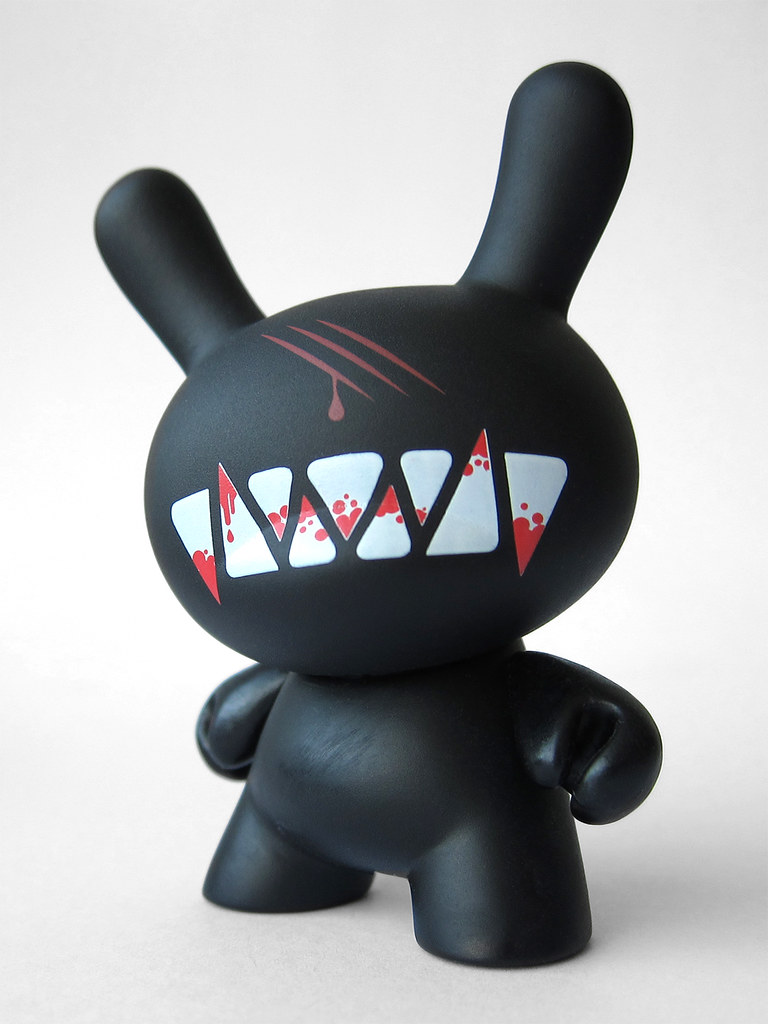
These little guys were actually my first introduction to the world of "vinyl toys." I first noticed them in a few of the art magazines I used to read, but they never truly caught my attention until I got a look at them in person. Several years ago, a local toy boutique opened up on a nearby street and I finally had a chance to learn a bit more about his whole "art toy" scene that everyone was so excited about. Stepping through the doors, I was instantly exposed to a whole new world of collecting. It was all so foreign at the time, I was completely unfamiliar with just about everything around me. A glass display case in the center of the shop housed a wide array of larger vinyl pieces from designers like Pete Fowler, Buff Monster, Junko Mizuno, and Frank Kozik. The surrounding walls had shelves filled with various blind box series, everything from Qees to Ci-Boys and of course, Dunnys.
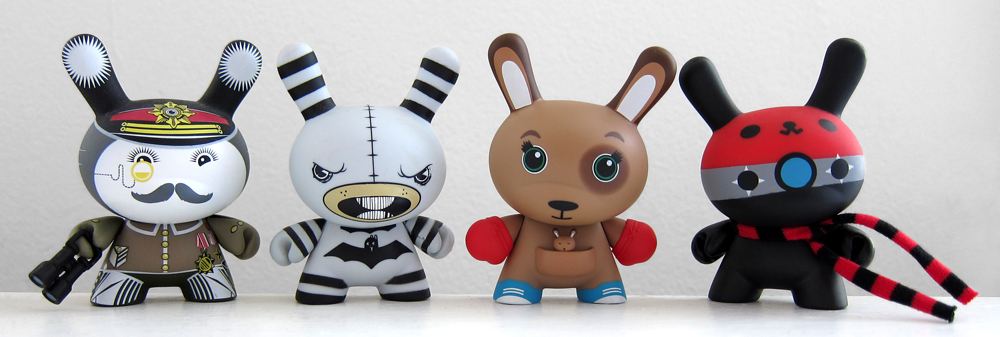
It's hard to explain the appeal of these things, but for me personally it has a lot to do with my history. I've been buying and collecting toys ever since I was a little kid, when my father would occasionally bring home random Go-Bots and Transformers after work. It was at this early age when my love of robot toys was forever cemented. As I grew older I continued to add to my collection, mostly focusing on transforming robots and action figures based on comics or animation. During college my tastes shifted and I started buying a ton of McFarlane action figures, and pretty soon I had several shelves densely packed with these figures. As much as I loved them, after a while they all started to blend together.
As dynamic and intricately detailed as these toys were individually, they lost something when viewed as a clustered group. I suppose you could compare it to a museum where they tried to fit every sculpture and painting against one wall, layering them several deep with the biggest ones in the back. I know that there's a big difference between a museum piece and an action figure, but both need a little space to breathe so they can be fully appreciated. The trouble is that not every toy collector has the space to completely cover each wall with shelving, so most of us end up packing as much as we possibly can into a small display area.

One of the things that really intrigued me about the platform toys like the Dunny, BearBricks and Qees is that they all had the same base shape. When you lined a whole bunch of them up together it looked like an organized collection, not just a random accumulation of objects. Not only that, but the bright colors and vibrant designs were the complete opposite of the dark gray and maroon color schemes I'd been staring at for years. It brought back memories of the neon robots and fluorescent plastic toys from my childhood. It was a breath of fresh air, and it didn't take me long to become completely hooked.
Of course I started out just buying one, telling myself that I would be happy with a single Dunny. But then after studying the sides of the box with the images of all the other designs...I decided to go back for just one more. Or two. Why not? I mean, having three together would be neat. I figured that I could quit at any time, but pretty soon I was buying 6 at once and coming back every few days for more.

Dunnys, like many other 3" mini series, are sold blind boxed. This means you don't get to see which specific design you got until after you've bought and opened the box. It's really a brilliant marketing scheme...it combines the obsessions of collecting with the compulsiveness of gambling. Not only is there the thrill of the hunt, the quest to obtain every toy in a set, you've also got the random reward aspect. Any box could contain a super rare piece, so the more you buy the better your chances are of finding it! In reality, of course, scoring a rare chase from a blind box set is about as likely as winning the lotto after buying hundreds of scratch off tickets. The odds aren't as astronomical, but you could easily spend hundreds of dollars, end up with piles of duplicates, and still not find the one toy you're looking for.
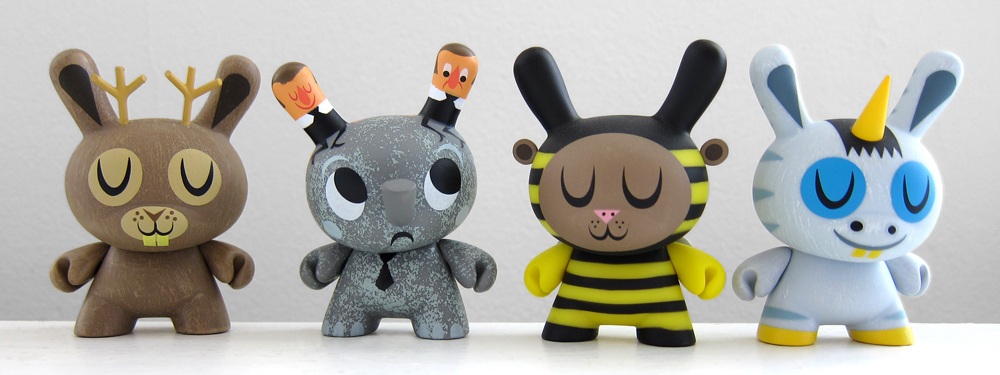
Another apsect of platform toys that interested me was the concept of a 3D canvas. I like the idea of seeing what some of my favorite artists could do when given the challenge of "painting" a toy. What's really neat is this allows someone who is an Amanda Visell fan, for instance, to own a small reproduction of her art for around 10 bucks. Her Dunny designs are actually based on a set of 8" customs she made for a KidRobot show, so there's a feel of authenticity to them. It's also very interesting to see which artists rise to the challenge and really push themselves, showcasing their talents...and which ones phone it in. I'm not going to start naming anyone, because this is pretty subjective, but some of my favorite designers have churned out awful Dunnys, while others have gone the extra mile and made amazing little toys. Some artists seem content to just draw on the shape, giving the effect of graffiti or stickers on a Dunny shape, missing the point entirely. Then there are the artists that seem to "get it" and understand the dimensions of the object, how to use it to their advantage and work with their personal style.

Dunnys will often get a drastically different reaction from the different breeds of toy collectors. They tend to be the favorites of "new" fans, serving the purpose of a gateway toy to get you addicted to the heavier stuff. For this reason I think many older and more "serious" collectors look down on them, seeing the format as something cheap for the younger crowd to fawn over. After all, these toys have a manufactured rarity, they're designed from the start to be collectibles, unlike actual collectible toys that were produced for children and have become rare decades later. The Dunny packaging makes sure to plaster statistics everywhere, letting you know exactly how rare every design is, and therefore, how valuable it is. There's also a debate about the quality of the vinyl used to make the toys, the aesthetics of platform toys versus original sculpts, and plenty of other issues have filled many a message board thread. Personally, I think they're perfectly fine for what they are, and if you like them, then you should have fun collecting them.

If you're trying to complete a full set of Dunnys you might have to spend up to $80 for a 1/100 ratio toy, not because it's actually worth that much, but because the person selling it knows that it's scarce. The result is a ton of eBay auctions for these allegedly "rare" toys, but often they will sit there and not sell. If thirty people are online trying to sell a toy and no one's buying, can you still call it "rare"?
If you really want it however, you might just have to bite the bullet, or find someone on a forum willing to trade with you or give you a deal. The only other option is to keep buying more boxes, which at almost $10 per toy could end up costing well over a few hundered dollars. If you go by the actual stats, you should run across 1 for every 100 toys you buy, which is right around $1,000. Suddenly just spending 80 bucks seems pretty reasonable...

I've actually had unusually good luck when it comes to blind box toys. I will normally buy about 15 Dunny's per series, and out of that I'll often get about 7 or 8 unique toys. Trading my duplicates might land me one or two more, but by that point the doubles I'm left with are the same common designs that everyone else is trying to get rid of, so those get stored away. I will occasionally pull the 1/50 designs, but never the 1/100.
The trouble with bind boxes is that when you first start into a new series, your luck is statistically great. If you've only got one or two toys, there's an excellent chance that the next box you open will be one that you don't have yet. When you've hit the halfway mark, however, it's a little different. Suddenly the odds are stacked against you, not only because you've already got half the series but because all the ones you're looking for are exceedingly rare. I've heard of collectors buying several cases and still not finding that elusive 1/100 toy. It's so hard to stop though...even when you know the odds are horribly against you.
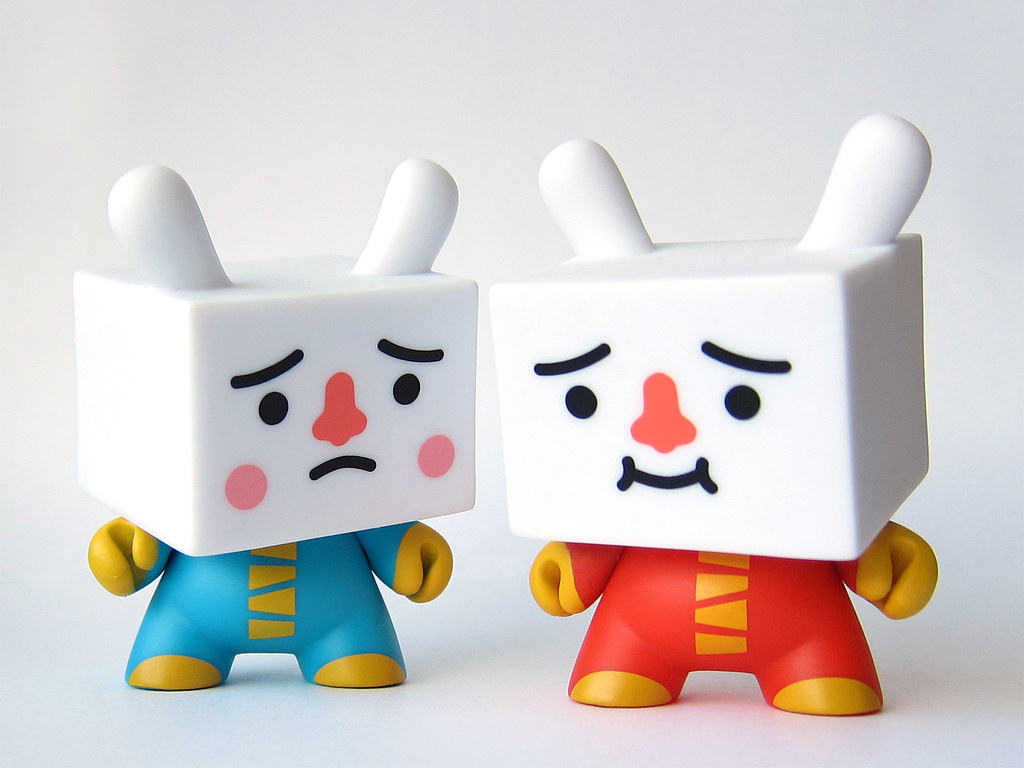
Of course, since it's completely random you could in theory buy just one box and end up pulling an obscenely rare figure. That's part of what makes it fun, the excitement and hope that you'll score that holy grail, the long sought after rare item that will be the crown jewel of your collection. It's also what makes it so frustrating, nothing is quite as depressing as dropping 60 dollars on toys only to end up with six figures you already have. As I mentioned earlier, it's a little like the lottery, you can't help but keep coming back with that hope of winning big, but more often than not you walk away with nothing. That's why I tend to just stop myself after I reach the halfway point. I might grab one or two more if I'm in the shop, but I'm perfectly happy having ten great toys out of the 20 available. Long ago I come to terms with the fact that I was probably never going to be able to have a "complete" set.
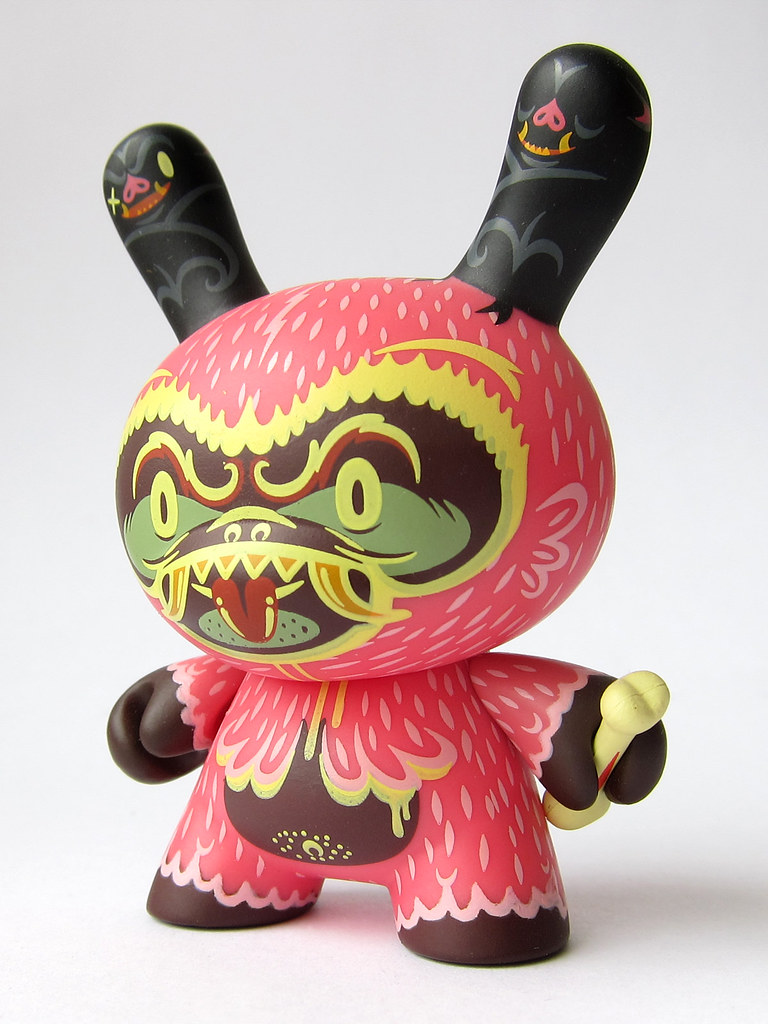
The actual paint jobs on Dunnys are usually pretty good. Occasionally there's a small misprinted area but for the most part they look like they are intended to. Every so often there are some odd quality control issues. For instance, I've noticed that on some of the earlier Dunny releases, several designs have arms that are not quite the same color as the body. Many of these arms aren't molded from the same colored vinyl used in the head and body of the figure, and the hand was painted in a shade that is close but not quite the same. When you're looking at these particular Dunnys from a short distance on a shelf they look okay, but if you get a bit closer it's kind of obvious that their arms don't match. I'm sure this is just the best that could be done at the time, but I have to wonder why the arms couldn't be made from the same vinyl.
Another annoying little problem is that the paint used on some of the earlier Dunny arms has a glossy and "sticky" feel. Instead of a flat paint that would match the appearance of the rest of the toy, it has a shine to it. Not a big deal, sure, but this glossy paint attracts dust and lint like crazy, and once it gets on there it's actually quite difficult to remove. Many of my Dunnys have been sitting on their shelf for years now, and you can easily recognize the ones with shiny, sticky, dust covered arms.

Much to the delight of overly critical people like myself, I'm happy to report that I haven't seen this problem on any of the recent series. The arms all look really great on every figure I've seen from The Endangered, 2009 and Femme Fatale series. I don't know what KidRobot did to fix it, but I'm guessing that with the popularity of the toys they could afford to put a little more money into the manufacturing process. Perhaps they just found a factory that produces a higher quality final product and figured out exactly which paint works for the little guys.
I knew that when I became more serious about this hobby I would end up spending quite a bit of money on it. Unlike action figures and transformers, these toys had significantly higher prices and would require a larger investment if I was going to build a real collection. At the height of my Dunny collecting, it wasn't unusual for me to spend around 100 dollars in one trip, just on blind box toys.

I was often tempted by the many larger vinyl toys available at the shop, but I never really considered buying any until I started spending so much on mini's. It was pretty easy to justify dropping 30 dollars for a single larger toy, since that was the equivalent of three blind box toys (which would probably be duplicates anyway). This opened up a whole new world of dangerous possibilities for me. All it takes is that first purchase to break the ice, now suddenly every 30 or 40 dollar piece was within my grasp. I picked up toys from DGPH, Bwana Spoons, Super7, Peskimo and more. Soon my shelves were being overrun with vinyl creatures ranging in size from 5" up to 9", taking the spotlight away from the little guys that started it all.
The first (and only) 8" Dunny that I bought was the Patricio Oliver "Zombie Pet" for $39.95. I just couldn't resist a glow in the dark toy with such a simple but effective design. I had always planned on getting a few more 8" Dunny's, and I kept waiting for another design that really appealed to me.
However the 8" price was nudged up to $50 when the Jeremyville 8" came out, and then suddenly jumped to $75 for the next few releases. It was alarming at first, but as each new design went on sale it became clear that KidRobot had decided this was the new starting price for the 8" Dunnys. I guess people must be buying them still, but it's just way, way more than I would ever pay for a toy like that. I have a feeling that it's probably turning away new fans that are in the same position I was a few years ago. If that 8" Patricio Oliver Dunny was originally priced at $75, there's absolutely no way I would have gone for it, it's just too much of a leap in cost. Going from roughly ten bucks per toy to 40 is reasonable when you have a limited budget. It's a lot harder to justify a price that is more than 7 times what you're used to spending.
It's been a while since I've bought a Dunny, and honestly I don't know if I'll be adding more to my collection anytime soon. I'm currently obsessing over a whole new variety of vinyl creatures, and my tastes have slowly shifted away from platform toys. That being said, I still have many of my favorite designs on display, and even though I'm not as enthusiastic about them as I once was, I've got a lot of fond memories of the time I spent collecting them. They really were my gateway toy, I might never have been introduced to the amazing (and addictive) world of vinyl toys that I love so much if it weren't for these little guys.
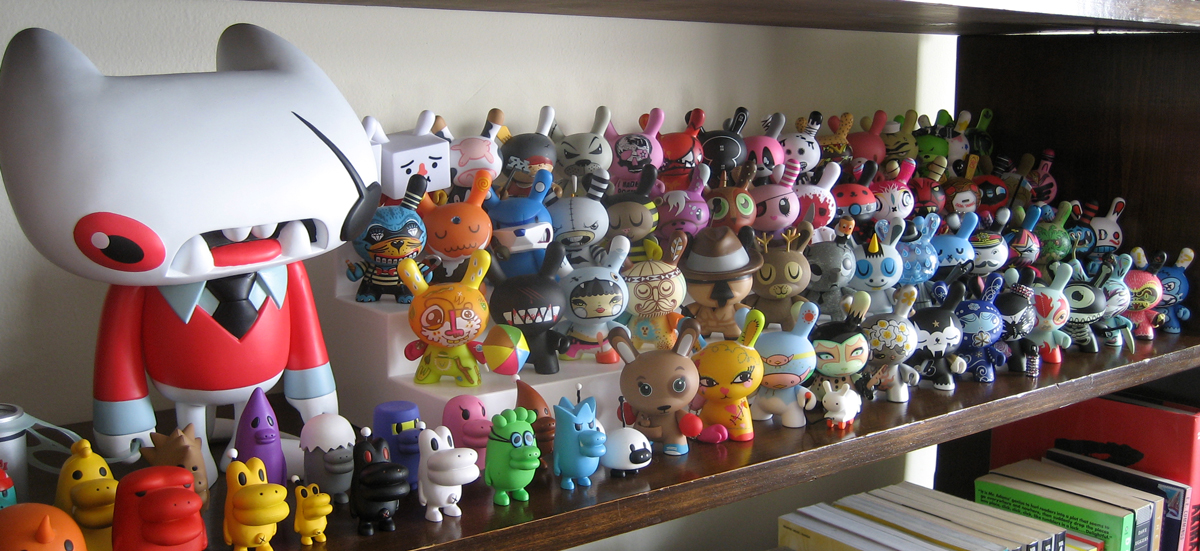

This entry was worth the wait. It's well-written and the photos are gorgeous.
ReplyDelete